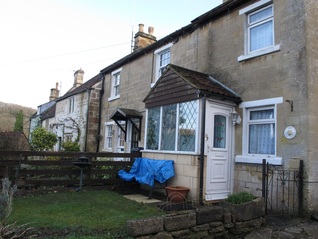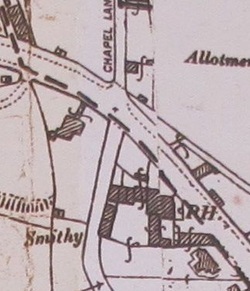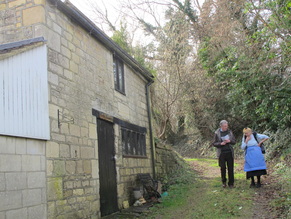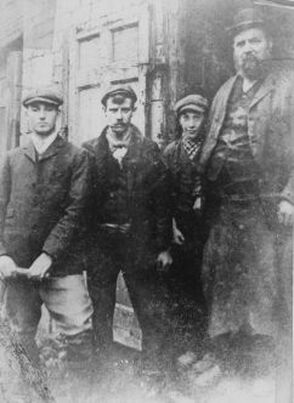|
Worthy George Phelps: Pye Corner Blacksmith 1852-1925 The fascinating story of Box's Blacksmith who lived in one of a tiny row of cottages called Pye Corner, off the Devizes Road. This article is indebted to the family history and photographs of Janice Cannings who was born at Pye Corner Alan Payne, March 2014 From Right to Left: Worthy Phelps, Samuel Cannings, George F Cannings and a customer; taken about 1909 (photo Janice Cannings) |
Worthy George Phelps
We are very fortunate to have this marvellous picture of Worthy George Phelps, Box's last village blacksmith. His story is fascinating: a life of extreme hard work and domestic conditions of poverty and tragedy. Worthy George Phelps deserved his name Worthy; he is an example to us all.
Worthy was born in Box on 11 July 1852, the fifth son of George and Caroline Phelps who lived at Quarry Hill. He became a blacksmith from the age of 18 whilst still living at home with his parents. Later he married a Welsh girl, Sarah Jane Thomas, on 28 March 1876 at the bride's home in Cardiff after which they returned to Box.
We are very fortunate to have this marvellous picture of Worthy George Phelps, Box's last village blacksmith. His story is fascinating: a life of extreme hard work and domestic conditions of poverty and tragedy. Worthy George Phelps deserved his name Worthy; he is an example to us all.
Worthy was born in Box on 11 July 1852, the fifth son of George and Caroline Phelps who lived at Quarry Hill. He became a blacksmith from the age of 18 whilst still living at home with his parents. Later he married a Welsh girl, Sarah Jane Thomas, on 28 March 1876 at the bride's home in Cardiff after which they returned to Box.

By 1891 the couple lived in the first cottage, No 1 Pye Corner, just off the Devizes Road (see left). It was a small property, probably as much as the couple could afford with a growing family.
It had the advantage of being only a few yards away from the smithy where Worthy carried on his self-employed trade as a blacksmith.
The smithy building still exists because it was mostly constructed of stone and able to withstand the chance of fire, albeit that the premises have been altered over the last 150 years.
The photo of Worthy shows him as a huge man (appropriate for his trade) but he wasn't a fierce man. We should imagine him more as a gentle giant. A local resident, Dennis Richman, talked fondly of the blacksmith and his kindness to local children, making or repairing metal hoops for them to roll along the street with a stick.
His life almost turned into tragedy when his wife became blind before 1901 aged 47. Worthy had to do most of the domestic duties, caring for her and their 10 children, including the younger children who needed his help. In all, seven of their children survived into adulthood, brought up in a four-roomed house without running water, electricity or an indoor lavatory. Worthy was a distinctly modern man in his attitude to life.
It had the advantage of being only a few yards away from the smithy where Worthy carried on his self-employed trade as a blacksmith.
The smithy building still exists because it was mostly constructed of stone and able to withstand the chance of fire, albeit that the premises have been altered over the last 150 years.
The photo of Worthy shows him as a huge man (appropriate for his trade) but he wasn't a fierce man. We should imagine him more as a gentle giant. A local resident, Dennis Richman, talked fondly of the blacksmith and his kindness to local children, making or repairing metal hoops for them to roll along the street with a stick.
His life almost turned into tragedy when his wife became blind before 1901 aged 47. Worthy had to do most of the domestic duties, caring for her and their 10 children, including the younger children who needed his help. In all, seven of their children survived into adulthood, brought up in a four-roomed house without running water, electricity or an indoor lavatory. Worthy was a distinctly modern man in his attitude to life.
What Does Pye Corner Mean?
Pye Corner was close to the centre of the village but distinctly separate from the other houses. It is an unusual area, a tiny row of four cottages now hidden behind Lamb House (the old Lamb Inn) just off Devizes Road. We can't be certain of the name's origin, but we can speculate that it harkens back to the Pye Corner area of London where the Great Fire of 1666 eventually burnt out.
The words blacksmith and Pye Corner occur in several places, including at Atworth and at Newport in Wales.[1] The furnace in the blacksmith's workshop was often the cause of fires when most houses were built of timber with thatch roofs. So the smithy was usually positioned outside the residential area for safety reasons. The cottages are much earlier than the rest of the area; Lamb Cottage and No 4 Pye Corner date from the late 1600s or early 1700s.[2]
The blacksmith was one of the vital trades before modern plastic goods. He was the repairer of almost all broken equipment from carts to pots, horseshoe provider, and saucepan manufacturer. As such a lot of people came to his door, so it might seem strange that his workshop was hidden away behind the old inn. But was it?
Pye Corner was close to the centre of the village but distinctly separate from the other houses. It is an unusual area, a tiny row of four cottages now hidden behind Lamb House (the old Lamb Inn) just off Devizes Road. We can't be certain of the name's origin, but we can speculate that it harkens back to the Pye Corner area of London where the Great Fire of 1666 eventually burnt out.
The words blacksmith and Pye Corner occur in several places, including at Atworth and at Newport in Wales.[1] The furnace in the blacksmith's workshop was often the cause of fires when most houses were built of timber with thatch roofs. So the smithy was usually positioned outside the residential area for safety reasons. The cottages are much earlier than the rest of the area; Lamb Cottage and No 4 Pye Corner date from the late 1600s or early 1700s.[2]
The blacksmith was one of the vital trades before modern plastic goods. He was the repairer of almost all broken equipment from carts to pots, horseshoe provider, and saucepan manufacturer. As such a lot of people came to his door, so it might seem strange that his workshop was hidden away behind the old inn. But was it?

The Devizes Road
The whole area was redeveloped when a new road, the Devizes Road, was completed in 1840, joining Box Fiveways and the village for the first time. New properties were built including the Lamb Inn, first referred to in 1848 when Peter Smith was the landlord.[3]
A map of 1919 shows the little row of cottages at Pye Corner to the left of PH (the Lamb Inn). The area is serviced by a track running up from Chapel Lane which then bends back on itself at Lyndale and back into the village via The Ley.
Nowadays this path is rarely used and not really suitable for traffic. But before the tollhouse was built at the foot of the Devizes Road, this road was a thriving thoroughfare for local traffic going into the centre. It is still sometimes called The Old Toll Road.
The whole area was redeveloped when a new road, the Devizes Road, was completed in 1840, joining Box Fiveways and the village for the first time. New properties were built including the Lamb Inn, first referred to in 1848 when Peter Smith was the landlord.[3]
A map of 1919 shows the little row of cottages at Pye Corner to the left of PH (the Lamb Inn). The area is serviced by a track running up from Chapel Lane which then bends back on itself at Lyndale and back into the village via The Ley.
Nowadays this path is rarely used and not really suitable for traffic. But before the tollhouse was built at the foot of the Devizes Road, this road was a thriving thoroughfare for local traffic going into the centre. It is still sometimes called The Old Toll Road.
Cannings Family
Worthy Phelps could never afford to buy his house or the forge but he rented it from another resident at Pye Corner. George F Cannings and his young son, Samuel, shown in the photo at the top of the page, were the landlords of the Phelps family. The Cannings family weren't part of the Victorian middle class establishment but they owned the whole row of cottages, very unusual at the time. The story of the Cannings family is just as curious as that of the blacksmith Phelps.[4]
The Cannings' money derived from the marriage of George's father, James, to Mary Bullock of Corsham. She was the daughter of a wealthy family of clockmakers who manufactured two prominent local clocks: one opposite the Hare and Hounds pub at Pickwick; and another which was above the front door of Clock House, since demolished to make way for the Co-op building in the High Street. She married James in her twenties and he was twelve years older than her.
James and Mary had mixed fortunes in their marriage. In 1851 they are recorded as shopkeepers at Ashley with a young daughter, Grace, aged 1 year. They were wealthy enough to employ a house servant. Family anecdotes record that at one point they occupied a farm and a pub at Ashley; and later ran a business of hauling stone quarry blocks by horse and wagon.
Worthy Phelps could never afford to buy his house or the forge but he rented it from another resident at Pye Corner. George F Cannings and his young son, Samuel, shown in the photo at the top of the page, were the landlords of the Phelps family. The Cannings family weren't part of the Victorian middle class establishment but they owned the whole row of cottages, very unusual at the time. The story of the Cannings family is just as curious as that of the blacksmith Phelps.[4]
The Cannings' money derived from the marriage of George's father, James, to Mary Bullock of Corsham. She was the daughter of a wealthy family of clockmakers who manufactured two prominent local clocks: one opposite the Hare and Hounds pub at Pickwick; and another which was above the front door of Clock House, since demolished to make way for the Co-op building in the High Street. She married James in her twenties and he was twelve years older than her.
James and Mary had mixed fortunes in their marriage. In 1851 they are recorded as shopkeepers at Ashley with a young daughter, Grace, aged 1 year. They were wealthy enough to employ a house servant. Family anecdotes record that at one point they occupied a farm and a pub at Ashley; and later ran a business of hauling stone quarry blocks by horse and wagon.
 The blacksmith workshop
The blacksmith workshop
When they retired from business, they moved to Pye Corner and built a stables for the horses. But being a brand new, stone building it was unsuitable as a stables; the horses caught pneumonia; and they died.
The stables were then converted into the smithy that Worthy Phelps rented.
In 1911 all these families were listed as living at Pye Corner. Blacksmith Phelps and family lived at cottage number 1. George F Cannings, his wife and family including Sam were in cottage number 2. At this time George was working as a plate-layer for the Great Western Railway. And in cottage number 4 was the aunt, Grace Cannings, who worked as a cook.
The blacksmith's shop probably never earned much and Worthy's work was limited by domestic responsibilities. He died aged 72 on 16 March 1925. Before then the business had closed and no one took it over. The world had moved on dramatically after the Great War and life in Box was never the same again.
In a separate article you can read about the use of Box's Fire Brigade during this period.
The stables were then converted into the smithy that Worthy Phelps rented.
In 1911 all these families were listed as living at Pye Corner. Blacksmith Phelps and family lived at cottage number 1. George F Cannings, his wife and family including Sam were in cottage number 2. At this time George was working as a plate-layer for the Great Western Railway. And in cottage number 4 was the aunt, Grace Cannings, who worked as a cook.
The blacksmith's shop probably never earned much and Worthy's work was limited by domestic responsibilities. He died aged 72 on 16 March 1925. Before then the business had closed and no one took it over. The world had moved on dramatically after the Great War and life in Box was never the same again.
In a separate article you can read about the use of Box's Fire Brigade during this period.
References
[1] Newport http://en.wikipedia.org/wiki/Nash,_Newport and Atworth local anecdote
[2] www.britishlistedbuildings.co.uk/england/wiltshire/box
[3] Kelly's Directory, 1848, Wiltshire & Swindon History Centre, Chippenham
[4] See the Cannings Family article under the Blog tab
[1] Newport http://en.wikipedia.org/wiki/Nash,_Newport and Atworth local anecdote
[2] www.britishlistedbuildings.co.uk/england/wiltshire/box
[3] Kelly's Directory, 1848, Wiltshire & Swindon History Centre, Chippenham
[4] See the Cannings Family article under the Blog tab
